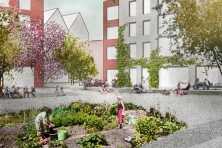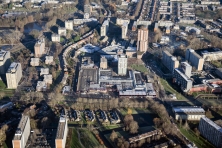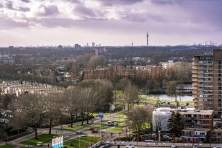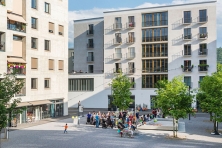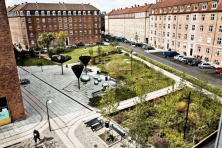Hartland
Rotterdam Groot Ijsselmonde (NL) - Winner
TEAM DATA
Team Representative: Zuzana Jancovicova (SK) – landscaper; Associates: Davor Dušanić (SI) – landscaper; Katarína Labathova (SK), Ida Bjallerbæk Pedersen (DK) – architects
Fred. Roeskestraat 90A-51, 1076ED Amsterdam (NL)
+31 6 84 864 953- info@laarc.eu – www.laarc.eu
See the complete listing of portraits here
See the site page here

D. Dušanić, K. Labáthová, .Z Jančovičová & I. Bjallerbæk Pedersen
VIDEO (by the team)
INTERVIEW
1. How did you form the team for the competition?
Europan was a great opportunity to form a project within our scope of knowledge and interest. All of us were eager and curious about working outside the daily office responsibilities. We formed our team at the initiative of Zuzana, who is a former colleague of Ida and Davor. We have got to know Katarína through architecture cinema. This was the first time that we have worked together. When forming a team, it was important to balance our different skills, background and professions.
2. How do you define the main issue of your project, and how did you answer on this session main topic: the place of productive activities within the city?
We have spent a lot of time discussing the concept of the garden city, its manifestation in the current context and connection to the productivity topic. The analysis of locations’ problems and qualities helped us form the main design principles, such as hierarchy in spatial & programmatic organisation and scales of sharing. We have explored the productivity topic from the environmental, social and economic standpoints and came to the conclusion that the latter-day productive garden city should be a naturally and socially inclusive suburbia. A productive garden city should enable slow and organically induced development of healthy community life while strengthening its landscape characteristics. We see the future productive city as a sum of activities that encourages active citizenship and shared responsibility.
3. How did this issue and the questions raised by the site mutation meet?
Being inspired by socialist and economic ideals of original Garden city utopia, the Hartland project provides a development strategy based on principles of commons and co-creation. We create a robust urban framework that accommodates socio-economic diversity in living typologies and creates opportunities for a dynamic cityscape to emerge. Different scales of sharing have different spatial implications. The Green canal represents a new organisational element in the urban fabric of Groot IJsselmonde. It is a strategic system of open spaces organised along the ring road, which binds the separate neighbourhood. By downgrading the existing street profile, we created extra space for ecology, water management and social activity. The mixture of different urban functions take place in the newly defined centre of Groot IJsselmonde. The site provides diversity of housing possibilities catering to various age groups. Densification and mixing living and working typologies along with a diversity of public spaces and services creates a neighbourhood for the future.
4. Have you treated this issue previously? What were the reference projects that inspired yours?
Separately we have been studying themes such as ageing suburbs in Denmark or flood mitigation & water management in Prague. The team, having a diverse background, was experienced with topics such as identity, urban ecology, shared mobility, local production, co-living/co-working, diversity and affordability of housing typologies. This was, however, the first time that we had explored such topics within complex social and spatial structures of an existing neighbourhood. It has been important to seek guidance in executed reference projects, that combine ideas of co-living & working and offer diverse models of development. One of the reference projects was the ‘Mehr als wohnen’ in Zürich, and the ‘Mietshäuser syndikat’, which proposes a different economical model of citizen organization. ‘Strijp-S’ in Eindhoven and the previous Europan project, ‘Klimakvarter’ in København (DK) are great examples of how a co-creation process can be organised.
5. Urban-architectural projects like the ones in Europan can only be implemented together with the actors through a negotiated process and in time. How did you consider this issue in your project?
This is a crucial part of our proposal. The plan is built around the principles of co-creation. We already did a small speculative research on how non-profit housing cooperatives work and proposed an economical model for a development of such a district. With an approach of urbanism based on landscape, we do not want to create a blue-print plan ready to build tomorrow, but rather let it grow with the help of a strong framework and intelligent management. The implementation of our plan requires further study and sharpening of the design framework and processes. We believe that Groot IJsselmonde is an ideal location to test an alternative development model due to its proximity to the city and is able to attract a new demographic group dreaming of living in a suburban setting with social qualities of the city.
6. Is it the first time you have been awarded a prize at Europan? How could this help you in your professional career?
Yes, this is the first time. We joined forces to mainly test our ideas and for personal development. This has been such a success and enormous validation for our work, which stimulates us to think about what we want for the future and boosting the confidence individually and as a collective of professionals. This being said, we are looking forwards to get in touch with other involved parties and to see whether the project continues and we can implement these ideas.
TEAM IDENTITY
Office: /
Functions: Architecture, Urbanism, Landscape
Average age of the associates: 30 years old
Has your team, together or separately, already conceived or implemented some projects and/or won any competition? If yes, which ones?
No, this is the first one that we have won a competition together.
